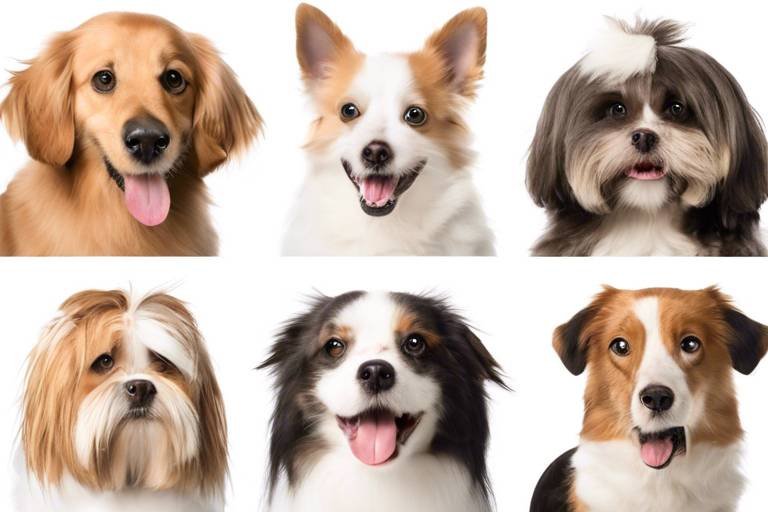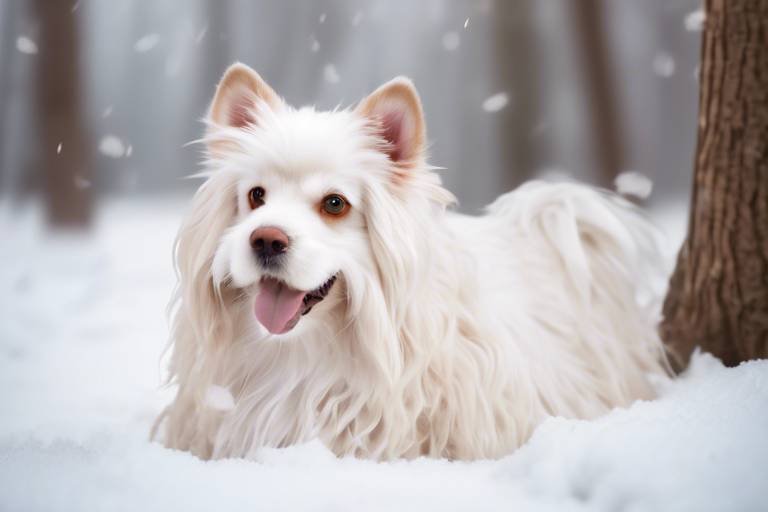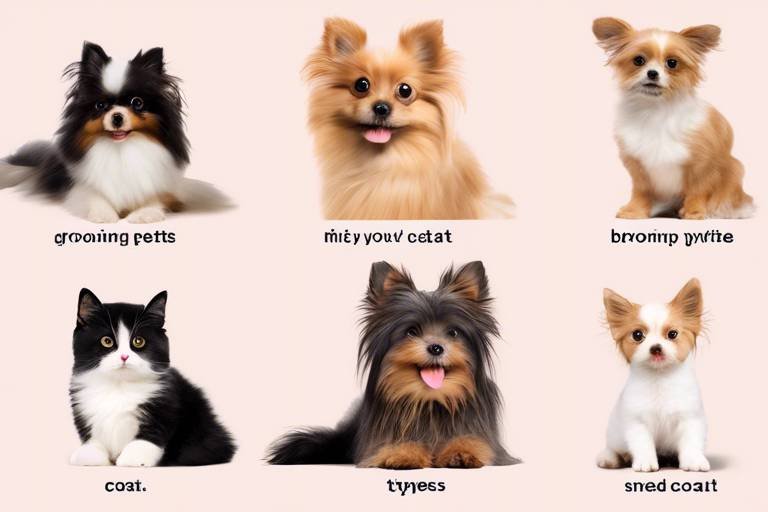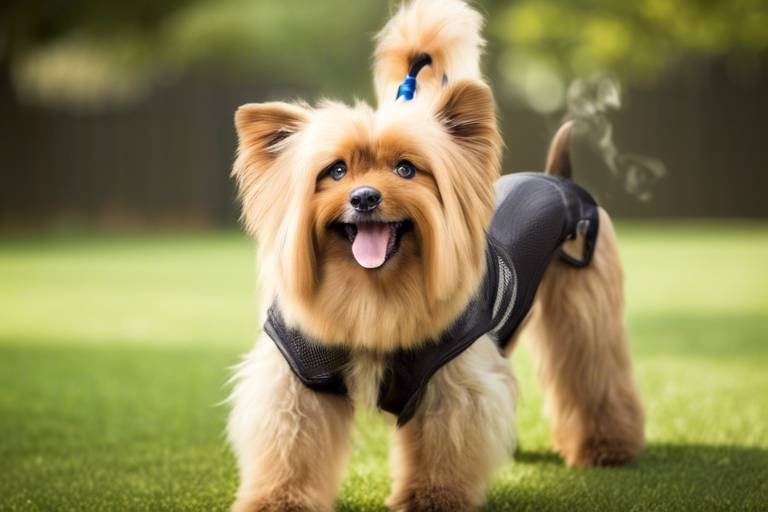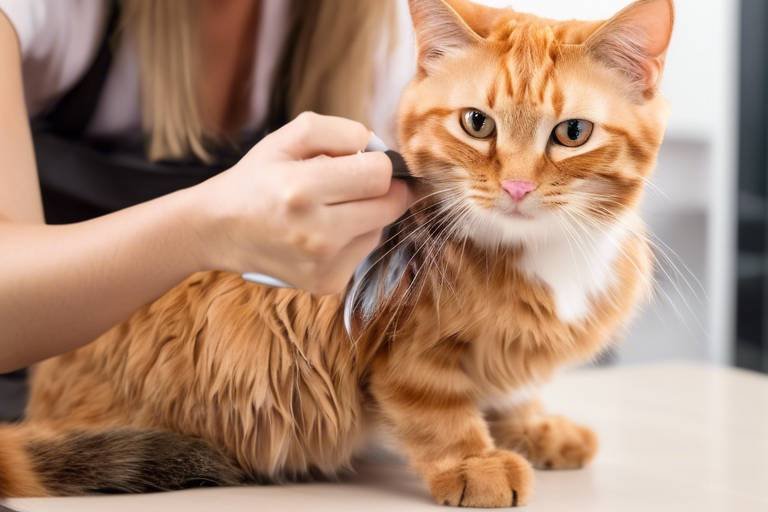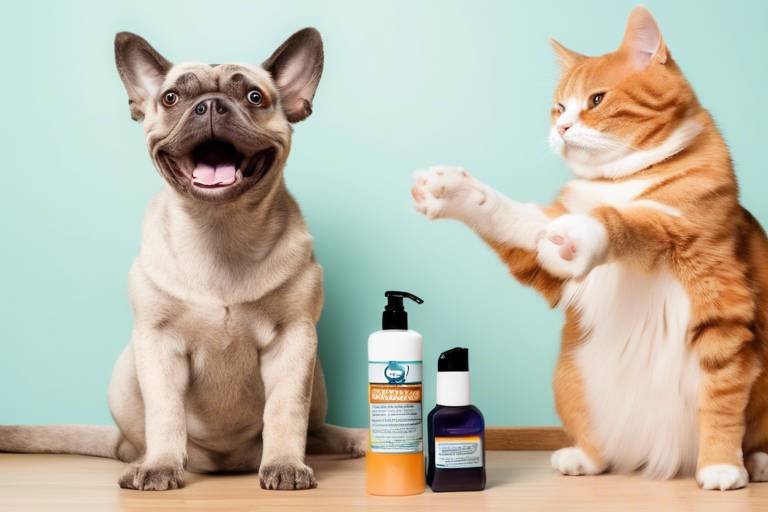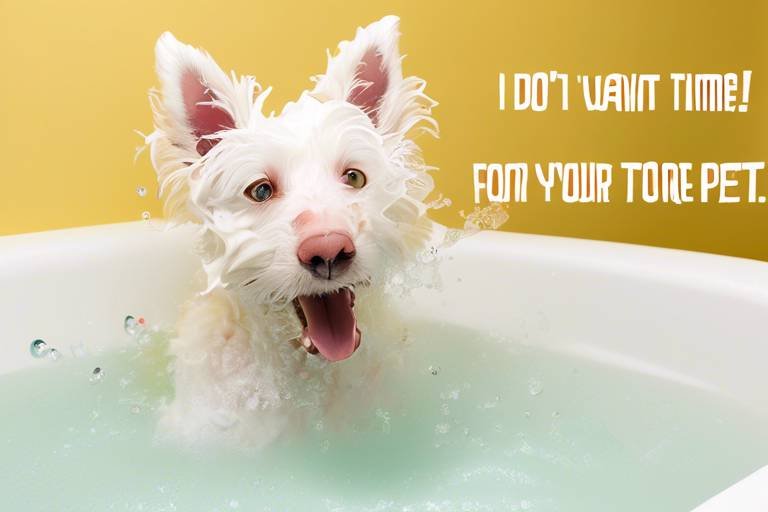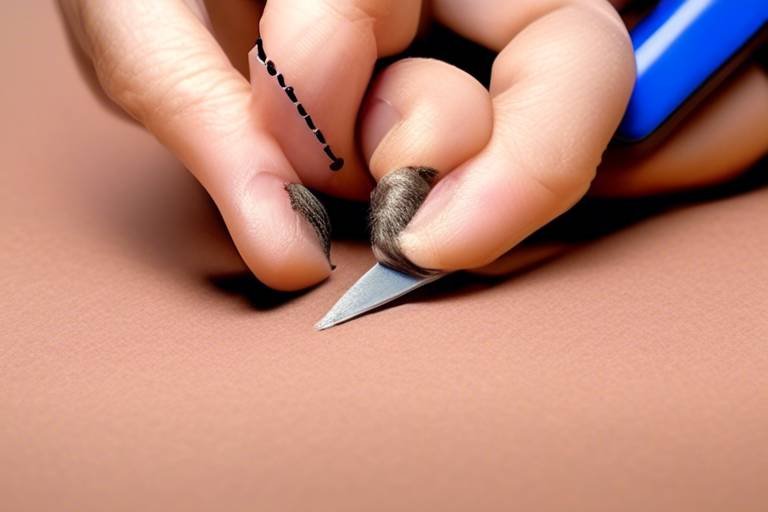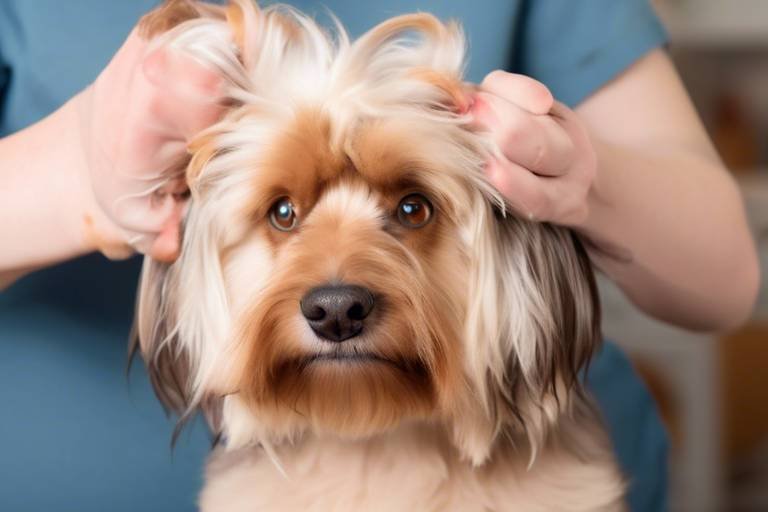The Best Practices for Grooming Small Breeds
Grooming your small dog is more than just a routine task; it's a vital part of ensuring their health and happiness. Just like us, our furry friends need a little TLC to stay looking and feeling their best. Whether you have a feisty Chihuahua or a fluffy Pomeranian, understanding the specific grooming needs of small breeds is essential. This article dives deep into the best practices for grooming small breeds, focusing on everything from bathing to nail trimming. So grab your grooming kit and let's make this a fun bonding experience for both you and your pet!
Small dog breeds are adorable, but they come with unique grooming requirements that differ significantly from larger breeds. Their delicate skin, varying coat types, and even their size can influence how often and how thoroughly they need to be groomed. For instance, a small dog with a long coat, like a Maltese, may require daily brushing to prevent tangles, while a short-haired breed, such as a Dachshund, might only need brushing once a week. By understanding these needs, you can create a tailored grooming routine that promotes your dog’s overall health and comfort.
Selecting the right grooming tools is crucial for small breeds. Using the wrong brush or clipper can lead to discomfort or even injury. Here’s a quick rundown of the essential grooming tools you should consider:
- Brushes: Depending on your dog's coat type, you may need a slicker brush, bristle brush, or a comb.
- Clippers: A good pair of clippers designed for small breeds will help you manage their sensitive areas.
- Nail Trimmers: Opt for small, precise nail trimmers to avoid hurting your pet.
Different coat types require different brushes. For instance, if you have a small breed with a curly coat, like a Toy Poodle, a slicker brush is ideal for detangling. On the other hand, a smooth-coated breed like a Boston Terrier might only need a rubber curry brush to remove loose hair. Learning about the best brushes and combs for your specific breed ensures that you choose the right tool for effective grooming without damaging their delicate fur.
If your small breed sheds, specialized shedding tools can make a world of difference. Tools like de-shedding brushes or grooming gloves can help manage loose hair and keep shedding under control, making your home cleaner and your pet more comfortable. Regular use of these tools can also reduce the amount of hair that ends up on your furniture and clothes.
When it comes to grooming sensitive areas, using the right clippers and trimmers is essential. Look for clippers that are designed specifically for small breeds, as they are usually quieter and less intimidating for your pet. This can help create a smoother and safer grooming experience. Remember, practice makes perfect, so take your time and be gentle!
Bathing small breeds requires special care to ensure they enjoy the experience rather than fear it. Generally, small dogs should be bathed every 3 to 4 weeks, but this can vary based on their activity level and coat type. Always use a mild, pet-friendly shampoo that won’t irritate their skin. To make bath time more enjoyable, consider using a non-slip mat in the tub and warm water to keep them comfortable. After the bath, a good towel dry or even a blow dryer on a low setting can help keep their coat healthy and fluffy.
Proper nail trimming is vital for small breeds. Overgrown nails can lead to discomfort, pain, or even injury. Aim to trim your dog's nails every 3 to 4 weeks. If you're unsure how to do it, consult your veterinarian or a professional groomer. They can provide tips or even demonstrate the process for you. Remember, a stress-free experience for both you and your pet is the goal.
Different techniques can be used for trimming small breed nails. A common method is the 'quick' method, where you trim just the tip of the nail to avoid cutting into the quick, which can cause bleeding and pain. Using a nail grinder can also be a gentler alternative to clippers, allowing for a smoother finish. The key is to be patient and calm, turning nail care into a positive experience for your furry friend.
Understanding the signs of healthy nails is crucial. Healthy nails should be short, smooth, and free of cracks or splits. If you notice any discoloration or excessive growth, it’s time to take action. Regularly checking your small breed's nails can prevent issues down the line and ensure they remain comfortable and active.
How often should I groom my small breed? It depends on the breed and coat type, but generally, small breeds should be groomed at least once a week.
Can I use human shampoo on my dog? No, human shampoo can irritate your dog's skin. Always use a shampoo specifically designed for pets.
What if my dog hates baths? Start slowly, use treats, and create a positive environment. Gradually introduce them to water to help them feel more comfortable.
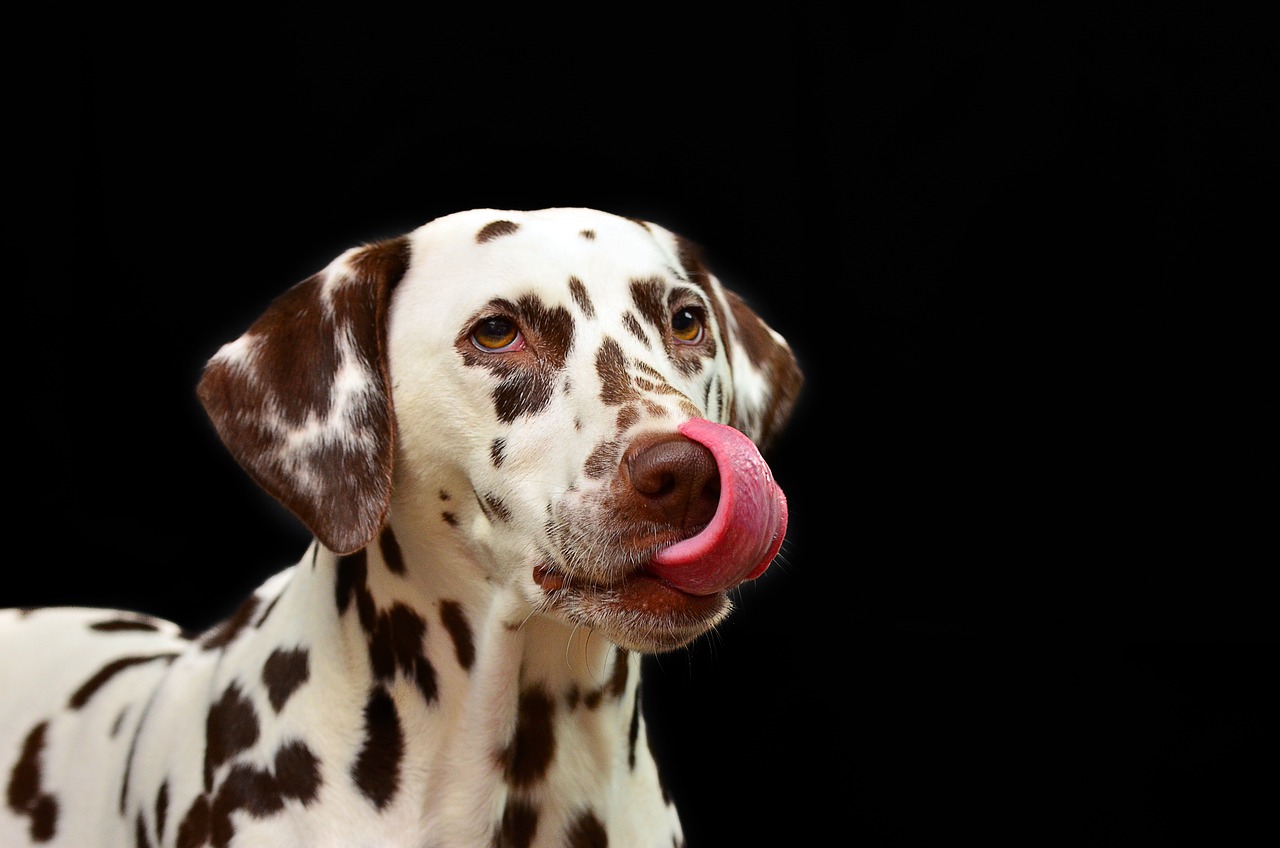
Understanding Small Breed Needs
When it comes to grooming small dog breeds, it's essential to recognize that they have unique needs compared to their larger counterparts. These little furballs may be small in size, but their grooming requirements are anything but trivial. Just like us, they have specific characteristics that dictate how we should care for them. For instance, small breeds often have more delicate skin and hair, making them more susceptible to irritation. This means that a gentle touch and appropriate products are crucial in your grooming routine.
Moreover, many small breeds tend to have varying coat types, which can range from long and flowing to short and sleek. Each coat type requires a different approach to grooming. For example, a Pomeranian's fluffy coat needs regular brushing to prevent matting, while a Dachshund’s short hair might require less frequent grooming. Understanding these nuances can make all the difference in maintaining your furry friend's health and happiness.
Another important aspect to consider is that small breeds often have a higher metabolism, which can lead to increased oil production in their skin. This means they might need more frequent baths compared to larger breeds. However, be cautious not to over-bathe them, as this can strip their skin of essential oils, leading to dryness and irritation. So, finding the right balance is key!
Additionally, small dogs are generally more prone to dental issues, so incorporating dental care into your grooming routine is vital. Regular brushing of their teeth can help prevent plaque buildup and keep their breath fresh. It's a small step that can lead to significant health benefits.
To summarize, understanding the grooming needs of small breeds involves recognizing their delicate skin, varying coat types, and specific health concerns. By tailoring your grooming approach to these factors, you can ensure that your little companion stays comfortable, healthy, and happy. Remember, grooming is not just about aesthetics; it plays a crucial role in your pet's overall well-being. With the right knowledge and tools, you can create a grooming routine that caters to the unique needs of your small breed.
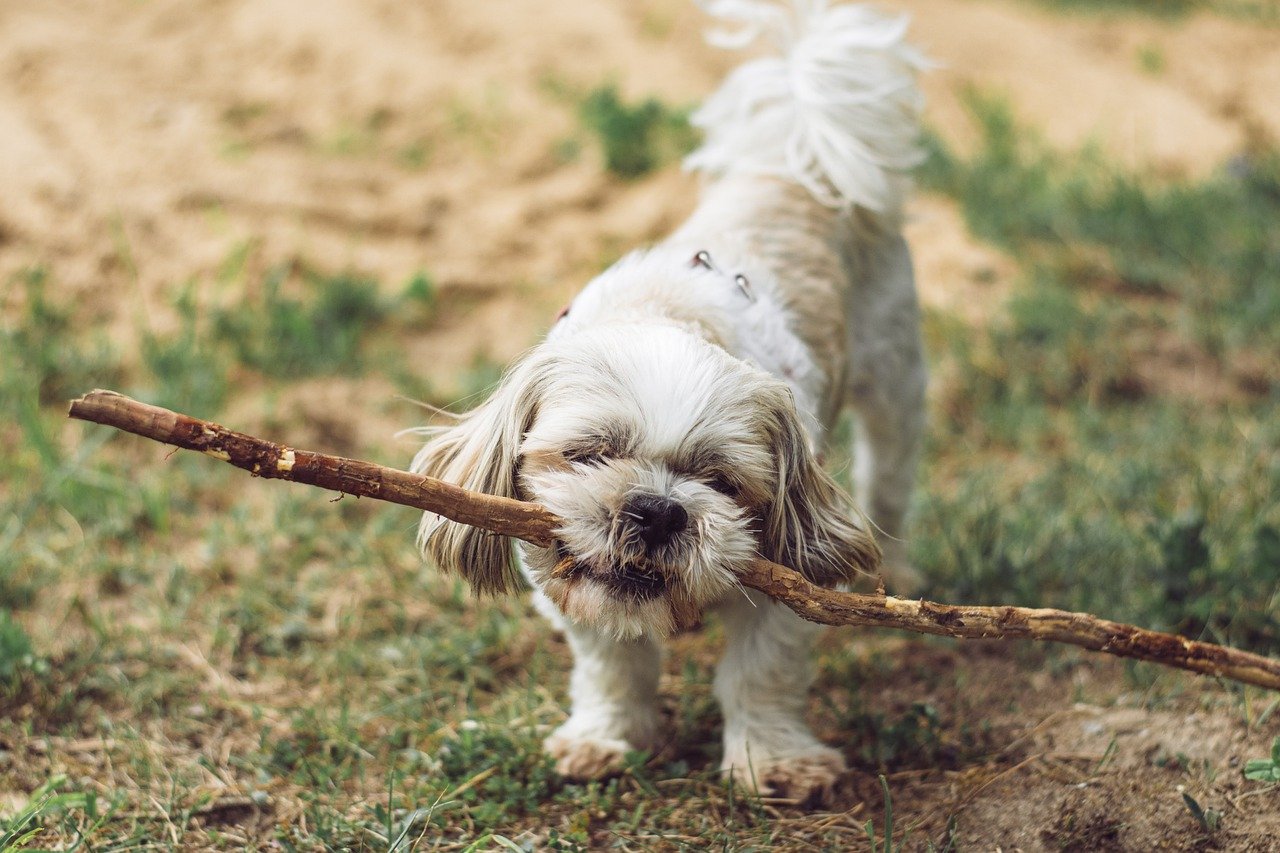
Choosing the Right Tools
When it comes to grooming your small breed dog, selecting the right tools is absolutely crucial. The right grooming tools not only make the process easier for you but also ensure that your furry friend remains comfortable and happy during their grooming sessions. Think of it like choosing the right paintbrush for a masterpiece; the right tools can make all the difference in achieving a beautiful finish. So, let’s dive into the essential tools you’ll need to keep your small dog looking its best!
First and foremost, you need to consider the type of coat your small breed has. Different breeds come with different coat types, which means they require different grooming tools. For example, a long-haired Chihuahua will need a different brush compared to a short-haired Dachshund. It’s like having a toolbox filled with various instruments; each tool serves a specific purpose. Here’s a quick breakdown of some essential grooming tools:
| Tool Type | Best For |
|---|---|
| Pin Brush | Long-haired breeds |
| Slicker Brush | Removing tangles and mats |
| Bristle Brush | Short-haired breeds |
| Comb | Finishing touches and detangling |
Next, let’s talk about shedding tools. Many small breeds shed, and having the right shedding tools can help you manage that fur explosion with ease. Specialized shedding tools, like de-shedding brushes or grooming gloves, can help to effectively remove loose hair without causing discomfort to your pet. It’s like having a magic wand that keeps your home fur-free while keeping your dog’s coat healthy!
Lastly, don’t underestimate the importance of clippers and trimmers. When grooming sensitive areas, such as around the eyes and paws, using the right clippers is essential. A quiet, low-vibration clipper can make a world of difference, turning a potentially stressful situation into a calm and pleasant experience for your dog. Imagine how you would feel if someone was using a loud, clunky tool near your face—definitely not a recipe for relaxation!
In summary, choosing the right grooming tools for your small breed is about understanding their unique needs and ensuring their comfort throughout the grooming process. Investing in high-quality brushes, shedding tools, and clippers will not only make grooming easier for you but will also contribute to your dog’s overall health and happiness. So, gear up, and get ready to pamper your little furball!
Brushes and Combs
When it comes to grooming your small breed dog, selecting the right is absolutely essential. Each breed has its own unique coat type, and using the appropriate tools can make a world of difference in keeping your furry friend looking their best. For instance, long-haired breeds like the Yorkshire Terrier or Maltese require a different grooming approach than short-haired breeds such as the Chihuahua or Pug.
Let's break it down a bit. If your small dog has a long, flowing coat, a pin brush is your best friend. This type of brush helps to detangle and smooth the fur, preventing those pesky knots that can lead to matting. On the other hand, short-haired breeds benefit greatly from a bristle brush, which is perfect for removing loose hair and distributing natural oils throughout their coat. It's almost like giving them a mini massage, which they will love!
But what about those breeds with curly or wavy fur? A slicker brush works wonders here. It has fine, short wires close together, making it effective at reaching the undercoat and removing tangles without damaging the outer coat. Remember, the goal is to keep your dog's coat healthy and shiny, while also making the grooming experience enjoyable for both of you.
To help you choose the right tools, here's a quick comparison table:
| Coat Type | Recommended Brush | Purpose |
|---|---|---|
| Long Hair | Pin Brush | Detangles and smooths fur |
| Short Hair | Bristle Brush | Removes loose hair and distributes oils |
| Curly/Wavy | Slicker Brush | Removes tangles from the undercoat |
In addition to brushes, combs are also important tools in your grooming kit. A wide-toothed comb is ideal for detangling, especially after a bath when your dog's fur is wet and more prone to knots. It’s gentle and helps to avoid pulling on their skin. Conversely, a fine-toothed comb can be used to check for any mats or tangles that need extra attention. Think of it as a detective tool, helping you uncover hidden issues before they become bigger problems!
In conclusion, investing in the right brushes and combs not only makes grooming easier but also enhances your small breed's overall health and well-being. Remember, grooming should be a bonding experience, so take your time and enjoy the process. Your furry friend will thank you for it!
- How often should I groom my small breed dog? It depends on the breed and coat type. Long-haired breeds may require daily grooming, while short-haired breeds might need grooming once a week.
- Can I use human brushes on my dog? It's not recommended. Dog brushes are specifically designed for their fur type and texture, ensuring a more comfortable experience.
- What should I do if my dog resists grooming? Make it a positive experience by using treats and praise. Gradually introduce them to the grooming tools.
Shedding Tools
When it comes to grooming small breeds, managing shedding can be a real game changer. These little furballs, while adorable, can leave a trail of hair that seems to magically appear everywhere! That’s where shedding tools come into play, making your life easier and keeping your home cleaner. But what exactly should you look for in a shedding tool? Well, it largely depends on your dog's coat type and shedding habits.
For instance, if you have a small breed with a double coat, such as a Pomeranian or a Shih Tzu, you’ll want to invest in a good de-shedding tool. These tools are designed to reach the undercoat and remove loose fur without damaging the topcoat. On the other hand, if your dog has a single coat, like a Chihuahua, a slicker brush might be more appropriate. Slicker brushes are fantastic for removing tangles and loose hair while being gentle on the skin.
Another option to consider is the shedding blade. This tool is particularly effective for breeds that shed heavily. It works by gliding over the coat to remove loose hair and is especially useful during the shedding season. However, it’s essential to use it gently to avoid scratching your dog’s skin. Remember, grooming should be a pleasant experience for your pet, not a chore!
To help you choose the right shedding tool, here’s a quick comparison of some popular options:
| Tool | Best For | Usage Tips |
|---|---|---|
| De-shedding Tool | Double-coated breeds | Use gently in the direction of hair growth. |
| Slicker Brush | Single-coated breeds | Brush in sections to avoid matting. |
| Shedding Blade | Heavy shedders | Use with care to prevent skin irritation. |
Incorporating these shedding tools into your grooming routine can significantly reduce the amount of loose hair in your home and keep your small breed looking fabulous. Plus, regular grooming helps to distribute natural oils in your dog’s coat, promoting a healthy shine. So, next time you’re gearing up for a grooming session, don’t forget your shedding tools—they're your best friends in the battle against fur!
- How often should I groom my small breed dog? It depends on the breed and coat type, but generally, brushing once a week is a good starting point.
- Can I use human grooming tools on my dog? It's best to use tools specifically designed for dogs to avoid harming their skin or coat.
- What should I do if my dog hates grooming? Try to make it a positive experience by using treats and taking breaks. Gradually introduce them to the tools.
Clippers and Trimmers
When it comes to grooming your small breed dog, choosing the right clippers and trimmers is essential for a smooth and safe experience. Small breeds often have sensitive skin and delicate fur, which means you need tools that are gentle yet effective. Investing in quality grooming tools can make all the difference, not just for your pet's comfort, but also for the ease of the grooming process.
There are various types of clippers and trimmers available on the market, and understanding their differences can help you make an informed choice. For instance, cordless clippers offer the freedom to move around without being tethered to an outlet, which is especially handy for wriggly pups. On the other hand, corded clippers can provide consistent power, making them ideal for longer grooming sessions. Whichever type you choose, ensure that the clippers are designed for small breeds, as they typically come with smaller blades that are more suitable for their size.
When selecting a clipper, consider the noise level as well. Some dogs may be frightened by loud sounds, so look for quiet models that will not startle your furry friend. Additionally, many clippers come with adjustable blade lengths, allowing you to customize the cut according to your dog's coat type. This feature is particularly useful for breeds with varying lengths of fur, as it allows for a more tailored grooming experience.
In addition to clippers, trimmers play a crucial role in maintaining your small breed’s appearance. Trimmers are particularly effective for areas that require precision, such as around the paws, ears, and face. A good quality trimmer should be lightweight and easy to maneuver, ensuring that you can navigate those tricky spots without causing any discomfort.
Here's a quick comparison of some popular clippers and trimmers for small breeds:
| Tool Type | Best For | Noise Level | Battery Type |
|---|---|---|---|
| Cordless Clippers | General grooming | Low | Rechargeable |
| Corded Clippers | Long grooming sessions | Medium | Plug-in |
| Trimmers | Detail work | Low | Rechargeable |
Before you start grooming, it’s also important to prepare your dog. Make sure they are calm and comfortable. You can do this by giving them treats during the process or letting them sniff the clippers and trimmers beforehand. This way, they can associate the tools with positive experiences. Remember, patience is key! If your dog seems anxious or restless, take a break and try again later.
In summary, the right clippers and trimmers can transform grooming from a chore into a bonding experience. By selecting tools that cater specifically to small breeds and understanding how to use them effectively, you can ensure that your furry friend looks their best while feeling comfortable and happy.
Bathing Techniques
Bathing your small breed dog is not just about getting them clean; it’s an essential part of their grooming routine that can significantly affect their overall health and happiness. Small dogs often have sensitive skin, which means that the bathing process should be approached with care and attention. So, how often should you bathe your furry friend? Generally, small breeds should be bathed every 4 to 6 weeks, but this can vary based on their lifestyle, coat type, and any specific skin conditions they may have. If your pup loves to play in the mud or has a penchant for rolling in the grass, you might need to give them a bath more frequently.
When it comes to shampoos, always opt for products specifically formulated for dogs. Human shampoos can disrupt the pH balance of your dog’s skin, leading to irritation. Look for gentle, hypoallergenic options that are free from harsh chemicals. If your small breed has a specific skin condition, consult your veterinarian for recommendations on the best shampoo to use. Additionally, consider using a conditioner to keep their coat soft and manageable, especially if they have longer hair.
Now, let’s talk about the actual bathing process. Start by gathering all your supplies: shampoo, conditioner, a non-slip mat for the tub, towels, and a brush. A non-slip mat is crucial as it helps your small dog feel secure during bath time, preventing any slips or falls that could cause anxiety. Before you even turn on the water, brush your dog to remove any tangles and loose fur. This not only makes the bathing process easier but also helps reduce shedding.
When bathing, use lukewarm water and avoid getting water in their ears, eyes, and nose. It’s best to use a handheld sprayer or a cup to gently wet their coat. Apply the shampoo, starting from the neck and working your way down to the tail, making sure to lather it well. Rinse thoroughly to ensure no product residue is left, as this can lead to skin irritation. After rinsing, apply the conditioner if you choose to use one, and then rinse again.
After the bath, gently towel dry your pup. If they are comfortable with it, you can use a low heat setting on a blow dryer, but be cautious not to scare them. Always remember to reward your small breed with treats and praise throughout the bathing process to create a positive association with bath time. This will help make future baths much easier and more enjoyable for both of you!
In summary, bathing your small breed dog can be a delightful experience when done correctly. By choosing the right products, maintaining a gentle approach, and creating a calming environment, you can ensure that your furry friend not only looks good but feels great too. Happy bathing!
- How often should I bathe my small breed dog? - Generally, every 4 to 6 weeks is recommended, but it can vary based on their activity level and coat type.
- Can I use human shampoo on my dog? - No, it’s best to use dog-specific shampoos to avoid disrupting their skin’s pH balance.
- What if my dog hates baths? - Try to create a positive experience with treats and praise, and consider bathing them in a familiar environment.
- Should I use conditioner? - Yes, especially for long-haired breeds, it helps keep their coat soft and tangle-free.
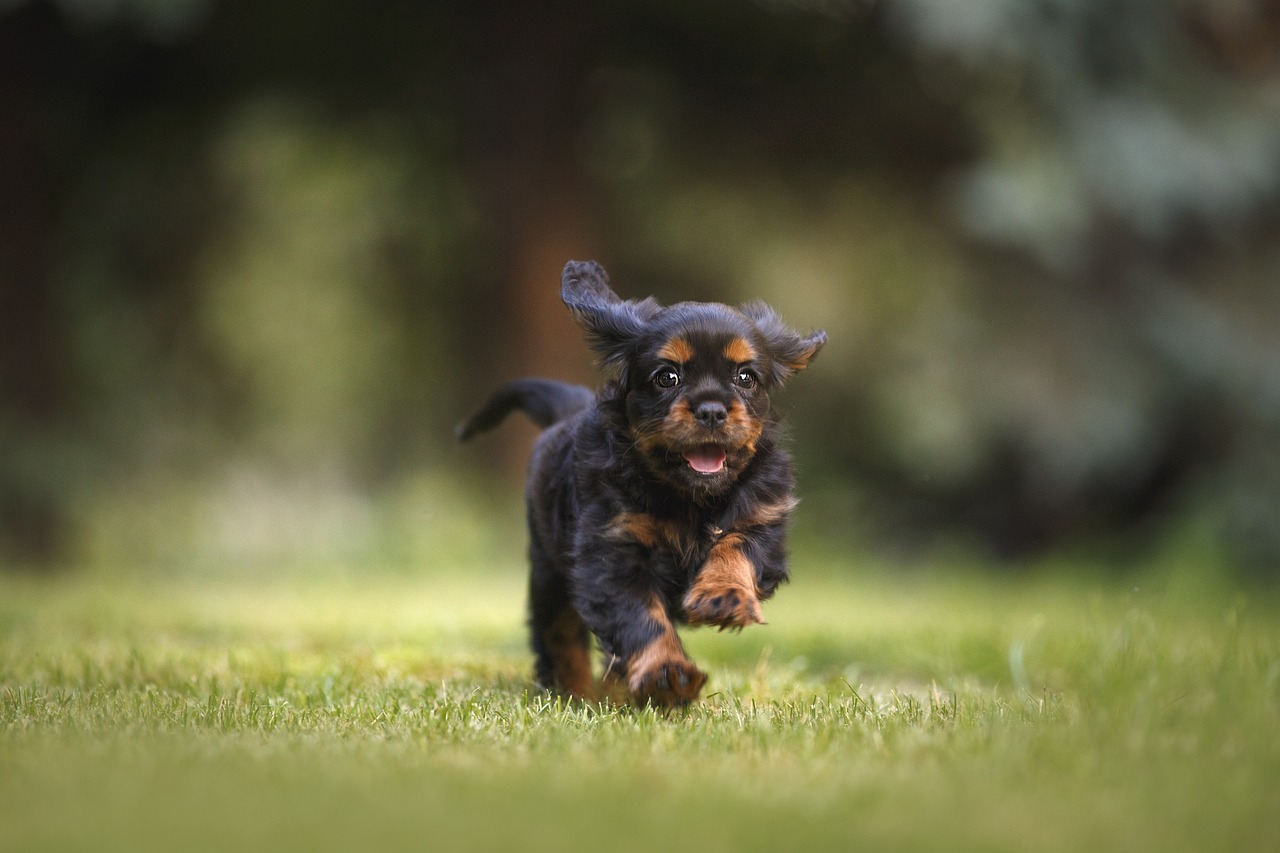
Nail Care Essentials
Nail care is an essential part of grooming for small dog breeds, and it’s not just about aesthetics. Keeping your furry friend's nails trimmed is crucial for their health and comfort. Just like us, dogs can experience discomfort if their nails are too long. They can snag on surfaces, leading to painful breaks or tears. Moreover, overgrown nails can affect their walking and posture, potentially leading to joint issues over time. So, how often should you trim those little claws? Generally, a good rule of thumb is to check their nails every 3 to 4 weeks, but this can vary depending on their activity level and the surfaces they walk on.
When it comes to nail trimming, using the right tools is key. Nail clippers designed specifically for small breeds are ideal, as they offer precision and comfort. There are several types to choose from, including scissor-style clippers and guillotine-style clippers. Each has its advantages, but the most important thing is to choose a tool that feels comfortable for you to use. If you're unsure, consult your veterinarian or a professional groomer for recommendations.
Another important aspect of nail care is recognizing when your dog’s nails are due for a trim. Healthy nails should not touch the ground when your dog is standing. If you hear clicking sounds when they walk, it's time for a trim. To help you keep track of your small breed's nail health, consider creating a simple schedule. You can jot down the last trim date and set reminders for the next one. Below is a handy table to help you track your pet's nail care:
| Date of Last Trim | Next Trim Due | Notes |
|---|---|---|
| [Insert Date] | [Insert Date] | [Any Observations] |
Now, let’s talk about the actual trimming process. It’s essential to create a calm environment for your dog. You might want to do this after a walk when they are a bit tired, or you can use treats to reward them during the process. Hold their paw gently but firmly, and be cautious not to cut into the quick, which is the sensitive part of the nail. If you're nervous about trimming, you can always start with a small amount and gradually work your way down. Remember, patience is key!
In addition to trimming, regular nail care also involves checking for any signs of health issues. Look for cracks, splits, or discoloration, which can indicate underlying problems. If you notice any abnormalities, it’s best to consult your veterinarian. Keeping your small breed's nails healthy is a vital part of their overall grooming routine, ensuring they stay happy and active.
- How often should I trim my small dog's nails? Ideally, every 3 to 4 weeks, but it depends on their activity level.
- What tools do I need for nail trimming? A good pair of small dog nail clippers and possibly a nail file for smoothing edges.
- What if my dog is afraid of nail trimming? Try to create a calm environment, use treats, and take it slow. Consider consulting a professional groomer if needed.
- How can I tell if my dog’s nails are too long? If the nails touch the ground when standing or you hear clicking sounds when they walk, it’s time for a trim.
Trimming Techniques
When it comes to trimming your small breed's nails, it's essential to approach the task with care and precision. Small dogs often have delicate nails that can easily split or break if not handled properly. So, how do you ensure a stress-free experience for both you and your furry friend? First and foremost, create a calm environment. Choose a quiet space where your dog feels comfortable, and have all your tools ready to avoid unnecessary interruptions. This preparation helps to keep your dog relaxed and minimizes any anxiety they might feel during the grooming process.
One effective technique is the “quick trim” method. This involves trimming just the tip of the nail, which can be less intimidating for your dog. Start by gently holding your dog's paw, allowing them to get used to your touch. Gradually introduce the clippers, letting them sniff and inspect the tools before proceeding. When you’re ready, position the clippers at a slight angle to the nail, cutting just a small portion at a time. This approach not only reduces the risk of cutting into the quick (the sensitive part of the nail) but also helps your dog associate nail trimming with a positive experience.
Another technique worth considering is the “Dremel method”. This involves using a rotary tool to grind down the nails instead of cutting them. Many pet owners find this method less stressful for their dogs, as it creates a smooth finish and reduces the risk of splitting. If you opt for this method, ensure you introduce the Dremel slowly, allowing your dog to become familiar with the sound and vibration. Start with short sessions, gradually increasing the duration as your dog becomes more comfortable.
Additionally, consider rewarding your dog throughout the process. Treats, praise, and gentle petting can significantly improve your dog’s experience during nail trimming. After each successful trim, offer a treat or a toy as a reward. This positive reinforcement encourages good behavior and helps your dog associate nail trimming with something enjoyable.
In summary, the key to successful nail trimming for small breeds lies in patience, understanding, and the right techniques. Whether you choose the quick trim method or the Dremel approach, always prioritize your dog's comfort and safety. With practice and the right mindset, nail trimming can become a routine part of your grooming sessions that both you and your pet look forward to.
- How often should I trim my small dog's nails? It typically depends on the dog's activity level, but most small breeds require trimming every 3-4 weeks.
- What if my dog is afraid of nail trimming? Start slow, use treats, and create a positive environment. Consider seeking help from a professional groomer if necessary.
- Can I use human nail clippers for my dog? It's not advisable. Dog nail clippers are specifically designed to handle the unique structure of canine nails.
- What should I do if I accidentally cut the quick? Apply a styptic powder to stop the bleeding and soothe your dog. If the bleeding doesn't stop, consult a vet.
Recognizing Nail Health
When it comes to keeping your small breed dog happy and healthy, nail care is often overlooked. Just like humans, dogs rely on their nails for balance and mobility. Neglecting their nail health can lead to discomfort, pain, and even injury. So, how do you know if your furry friend's nails are in tip-top shape? Understanding the signs of healthy nails is crucial for every pet owner.
First and foremost, healthy nails should be short and well-trimmed. If you hear a clicking sound when your dog walks on hard surfaces, it's a sign that their nails are too long. Ideally, a dog's nails should not touch the ground when they are standing. This helps prevent painful splaying of the toes and reduces the risk of nail breakage, which can be quite painful for your pet.
Another key indicator of nail health is the color and texture of the nails. Healthy nails are typically smooth, shiny, and free of cracks or splits. If you notice any discoloration—such as a yellow or brown tint—it could be a sign of an underlying issue, such as an infection or fungal growth. In such cases, it's best to consult your veterinarian for advice.
Additionally, pay attention to your dog’s behavior. If your small breed is frequently licking or chewing at their paws, it might indicate discomfort due to overgrown nails or other nail-related issues. This behavior can also stem from anxiety or allergies, so it's essential to monitor their habits and consult a vet if you notice any changes.
To help you keep track of your dog's nail health, consider the following signs of healthy nails:
- Length: Should be short enough not to touch the ground.
- Color: Generally clear or light-colored, without discoloration.
- Texture: Smooth and shiny, free from cracks or chips.
- Behavior: No excessive licking or chewing of the paws.
Regularly checking your dog's nails and maintaining a grooming schedule can significantly enhance their quality of life. If you're unsure about how to trim your dog's nails or if you notice any concerning signs, don't hesitate to reach out to a professional groomer or your veterinarian. After all, a little attention to detail can go a long way in ensuring your small breed remains healthy and happy!
Q: How often should I trim my small dog's nails?
A: Generally, small dog nails should be trimmed every 3 to 4 weeks, but this can vary depending on their activity level and how quickly their nails grow.
Q: What if my dog does not like having their nails trimmed?
A: It's important to introduce nail trimming gradually. Start by getting your dog comfortable with having their paws handled. Use treats and positive reinforcement to make the experience more enjoyable.
Q: What tools are best for trimming small dog nails?
A: For small breeds, a pair of dog nail clippers designed for small dogs or a nail grinder can be effective. Choose tools that you feel comfortable using and that suit your dog's needs.
Q: Can I use human nail clippers on my dog?
A: While some owners do use human nail clippers, it's generally recommended to use clippers specifically designed for dogs to ensure safety and effectiveness.
Frequently Asked Questions
- How often should I groom my small breed dog?
Grooming frequency depends on your dog's coat type and lifestyle. Generally, small breeds with long or thick fur may require grooming every 4 to 6 weeks, while those with shorter coats might only need it every 8 to 12 weeks. Regular brushing in between grooming sessions will also help keep their coat healthy and free of tangles.
- What tools do I need for grooming my small dog?
The essential grooming tools for small breeds include a slicker brush, a comb, nail clippers, and a gentle dog shampoo. Depending on your dog's coat type, you might also want to invest in specific shedding tools or clippers for sensitive areas. Choosing the right tools can make a world of difference in your grooming routine!
- Can I bathe my small breed dog too often?
Yes, bathing your small breed dog too frequently can strip their coat of natural oils, leading to dry skin. It's best to bathe them every 1 to 3 months, or as needed if they get particularly dirty or smelly. Always use a dog-specific shampoo to ensure their skin and coat stay healthy.
- How do I trim my small dog's nails safely?
When trimming your dog's nails, it's important to use sharp, high-quality clippers and to be cautious not to cut into the quick, which can cause bleeding and pain. Trim just the tip of the nail and if your dog has dark nails, trim a little at a time until you see a lighter area indicating the quick. If you're unsure, ask a professional groomer or vet for guidance.
- What are the signs of healthy nails in small breeds?
Healthy nails should be short, smooth, and free of cracks or splits. They should not be overly long or curled, which can cause discomfort and lead to mobility issues. Regular checks and trims will keep your small breed's nails in tip-top shape and prevent any potential health problems.
- How can I make grooming a positive experience for my dog?
To make grooming enjoyable, start by introducing your dog to the grooming tools gradually. Use treats and praise to create a positive association. Keep sessions short and fun, and always end on a high note. Over time, your dog will learn to look forward to grooming time as a bonding experience!


